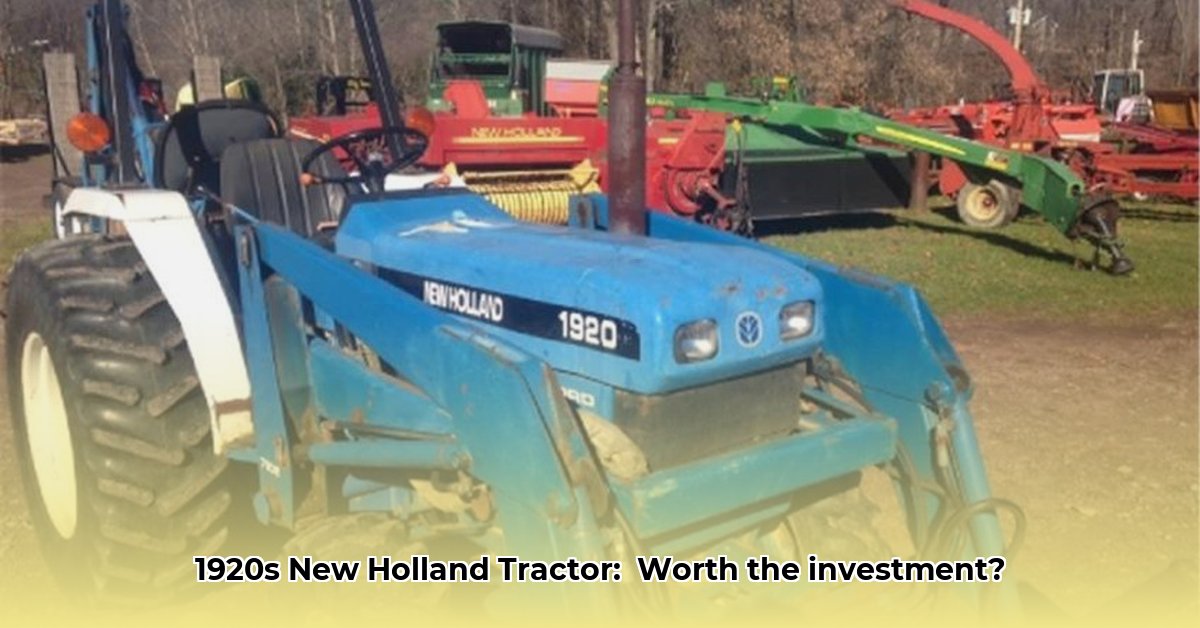
Ever considered owning a piece of agricultural history? The New Holland 1920 tractor, a compact machine built by Shibaura, offers a compelling blend of vintage charm and surprising practicality. Ideal for small farms, hobby farms, and landscapers, this tractor presents a unique ownership experience, but potential buyers should carefully weigh the pros and cons before committing. This buyer's guide will equip you with the knowledge to make an informed decision. For more on vintage tractors, check out this resource on 1940s Ford tractors.
Technical Specifications and Features: A Closer Look
The 1920 New Holland typically boasts a 32-33 horsepower engine (a respectable output for its era), a 12-speed transmission offering flexibility for various tasks, and an open-center hydraulic system capable of handling attachments such as mowers, snow blowers, or small front-end loaders. This relatively simple mechanical design, compared to modern counterparts, contributes to its easier maintainability, although this simplicity also limits its capabilities. Specific specifications can vary between models, so diligent research is crucial. Are you prepared to handle the nuances of a vintage machine?
Historical Context: Its Place in Time
Production of the New Holland 1920 spanned roughly from 1987 to 2000. During this period, it competed with compact tractors from manufacturers like Kubota and Yanmar, targeting the smaller-scale farming and landscaping sectors. Its original price (approximately $15,500 in 2000 dollars) positioned it as a mid-range option—a capable machine, but not designed for large-scale operations or heavy-duty tasks. Does its historical significance outweigh the challenges of vintage ownership?
Performance and Capabilities: Expectations vs. Reality
Finding precise performance data for a tractor of this age is difficult. Anecdotal evidence suggests reliable operation within the limits of its horsepower. Direct comparisons with newer models aren't entirely fair; it is essential to remember that the 1920 was built to a different standard and for different tasks. Thinking of it as a classic car compared to a modern sports car is helpful – both serve mobility needs, but their design and capabilities are distinct. What are your specific needs, and does the 1920 align with them?
Parts Availability and Maintenance: The Practicalities
This is likely the most challenging aspect of owning a 1920 New Holland. Parts availability can be limited due to the tractor's age and the cessation of original equipment manufacturer (OEM) support. However, the relatively straightforward mechanical design often simplifies repairs compared to modern tractors with complex electronics. Successful ownership hinges on your resourcefulness.
Actionable Steps for Sourcing Parts:
- Online Marketplaces: Begin your search on sites like Messicks or TractorPartsAsap.
- Specialty Suppliers: Look for suppliers specializing in vintage or classic tractor parts.
- Salvage Yards: Check local salvage yards or agricultural equipment dismantlers for potential parts.
- Online Forums: Tap into online communities focused on classic tractors for advice and potential parts leads.
- Custom Fabrication: For truly irreplaceable components, consider custom fabrication.
Does your mechanical aptitude and resourcefulness align with the necessary level of maintenance for this vintage machine?
Resale Value and Market Considerations: The Investment Angle
The resale value of a used New Holland 1920 is highly variable, depending on condition, rarity of specific models, and overall market demand. This is heavily influenced by collector interest—a well-preserved example will command a higher price than one requiring extensive repairs. Estimating a precise, current value is challenging given multiple unpredictable variables affecting the vintage tractor market. Will you be able to recoup your investment should you choose to sell?
Buyer's Guide: A Summary of Pros and Cons
| Pros | Cons |
|---|---|
| Relatively simple mechanical design | Parts availability challenges |
| Potential affordability (compared to new) | Limited readily available performance data |
| Suitable for smaller properties and tasks | Requires more hands-on maintenance and repair |
| Potential collector value | Resale value can fluctuate; niche market |
| Versatile with available attachments | May lack features found in modern, advanced models |
| A piece of agricultural history | Limited power compared to modern tractors |
Collectors’ Corner: A Piece of History
For collectors, the New Holland 1920 is a treasure, representing a specific era in agricultural technology. Its age and historical significance make it a highly sought-after item, but owning one requires commitment and preparedness for challenges. The hunt for specific parts, the search for specialized mechanics, and the preservation of history all contribute to an unique, rewarding experience. Is the collector’s journey something you are prepared to undertake?
Conclusion: Making the Right Choice
Purchasing a used New Holland 1920 tractor requires careful deliberation. A thorough inspection is crucial, preferably by a qualified mechanic. Understanding the challenges of parts sourcing and maintenance is paramount. Weigh the potential rewards—a reliable machine for smaller tasks and a piece of agricultural history—against the potential challenges. Only then can you decide if this vintage tractor is the right fit for you.